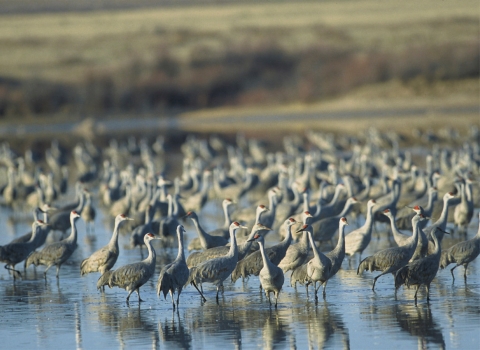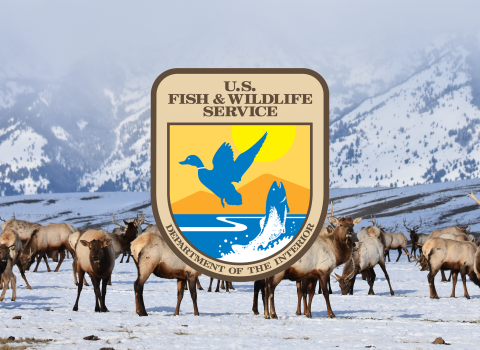In a move designed to maintain strong protections for bald and golden eagles, the U.S. Fish and Wildlife Service today announced it is opening a 60-day public comment period on proposed improvements to the agency’s comprehensive eagle conservation and management program. The proposed changes include modifications to the regulations governing permits for incidental take of bald and golden eagles that will protect eagle populations during the course of otherwise lawful human activities.
A simultaneous public comment period also opens on a related proposed programmatic environmental impact statement (PEIS). This PEIS forms an integral part of the environmental review process for the changes to the eagle permitting program. The Service also made public a new report assessing the status, trends and resiliency of bald and golden eagle populations. The report underpins the proposed revisions to the conservation and management program.
The Service is proposing the revisions to its bald and golden eagle regulations, which it administers under the Bald and Golden Eagle Protection Act (Eagle Act), in response to extensive public input since the original regulations were published in 2009. This includes comments received during a series of public information meetings. The proposed revisions build on that input and on an extensive review of the best available science.
“Eagles hold a revered place in our nation’s history and culture, particularly that of Native Americans,” said Service Director Dan Ashe. “The proposed regulations provide a path forward for maintaining stable or increasing eagle populations while also ensuring that limited and incidental take of eagles that occurs as a result of otherwise legal activity is tracked, permitted and, where possible, reduced.”
The proposed rule sets objectives for eagle management, addresses how populations will be monitored and managed, directs how data on permitted eagle mortality are obtained and used, and provides a framework for how the incidental take permitting system fits within the overall framework of eagle management.
The proposed regulations address the duration of permits for incidental take of eagles, extending the maximum permit duration to 30 years, subject to a recurring five-year review process throughout the permit life. Under the proposed revisions, only applicants who commit to adaptive management measures to ensure the preservation of eagles will be considered for permits with terms longer than five years.
The Eagle Act requires the Service to determine that any take of eagles it authorizes is “compatible with the preservation of bald eagles or golden eagles,” known as the “preservation standard.” The Service defines the preservation standard to mean “consistent with the goal of maintaining stable or increasing breeding populations.” It underpins the Service’s management objectives for both species. The Service is proposing to add the clause “and the persistence of local populations, throughout the geographic range of both species” to more clearly define conservation and mitigation efforts at the local scale and respond to state, tribal and other stakeholder input into our eagle conservation programs.
Other proposed provisions address compensatory mitigation requirements for golden eagles, application requirements, and a revised permit fee structure structure
Something temporarily or permanently constructed, built, or placed; and constructed of natural or manufactured parts including, but not limited to, a building, shed, cabin, porch, bridge, walkway, stair steps, sign, landing, platform, dock, rack, fence, telecommunication device, antennae, fish cleaning table, satellite dish/mount, or well head.
Learn more about structure that will ensure the Service has adequate resources to implement effective eagle permitting and conservation.
Non-purposeful or incidental take of eagles occurs throughout a range of industries, new and traditional. The system for permitting this take enables industries to work collaboratively and proactively with the Service to avoid, minimize and in some cases mitigate for their impact, while also providing critical data that can help the agency better track human causes of eagle mortality and manage eagle populations.
“The permitting system provides a mechanism for private companies to do the right thing,” said Ashe. “Many companies are making efforts to avoid killing migratory birds during design, construction and operation of industrial facilities, and we look forward to working with additional permit applicants to ensure their operations are compatible with efforts to conserve eagles.”
In its review of potential changes to the eagle conservation and management program, the Service relied on a significant body of current scientific data and findings, including its new report “Bald and Golden Eagles: Status, trends, and estimation of sustainable take rates in the United States.” The report is a compilation of the most current research on the population status and trends of bald and golden eagles and serves as the biological basis for the proposed regulation revisions and the preferred alternative in the PEIS.
The bald eagle was once in danger of extinction in the lower 48 states, with fewer than 500 nesting pairs remaining. It was removed from the endangered species list in 2007 because populations had recovered sufficiently. Golden eagles are protected due to concerns about their status, their similarity of appearance to bald eagles, and their ecological value as apex predators in ecosystems where they occur. Both bald and golden eagles are protected under the Eagle Act, Migratory Bird Treaty Act and the Lacey Act.
The new eagle status report indicates bald eagle populations have continued to rise throughout the United States—now numbering in excess of 143,000. At the same time, data suggest golden eagle populations may be starting to decline, heightening the importance of securing critical conservation measures through permitting to protect this species.
“For decades, the Service has demonstrated leadership and commitment to the conservation of bald and golden eagles,” said Ashe. “This rule recognizes the need to adapt eagle management to changes across the American landscape, including our own activities.”
The public may submit comments on the proposed rule and the PEIS until July 5, 2016. Both the proposed rule and the PEIS are available at http://www.fws.gov/birds/management/managed-species/eagle-management.php and also at www.regulations.gov at Docket No. FWS–R9–MB–2011–0094. Comments on the information collection aspects of this rule must be received on or before July 5, 2016.
Comments may be submitted by one of the following methods:
(1) Electronically: Go to the Federal eRulemaking Portal: www.regulations.gov. In the Search box, enter FWS–R9–MB–2011–0094, which is the docket number for this rulemaking. Then click on the Search button. On the resulting page, you may submit a comment by clicking on “Comment Now!”
(2) By hard copy: Submit by U.S. mail or hand-delivery to: Public Comments Processing, Attn: FWS–R9–MB–2011–0094; Division of Policy, Performance, and Management Programs; U.S. Fish and Wildlife Service, MS: BPHC; 5275 Leesburg Pike, Falls Church, VA 22041–3803.
Comments on the Information Collection Aspects of the Proposed Rule: You may review the Information Collection Request online at www.reginfo.gov. Follow the instructions to review Department of the Interior collections under review by OMB. Send comments (identified by 1018–AY30) specific to the information collection aspects of this proposed rule to both the:
- Desk Officer for the Department of the Interior at OMB–OIRA at (202) 295–5806 (fax) or OIRA_Submission@omb.eop.gov (email); and
- Service Information Collection Clearance Officer; Division of Policy, Performance, and Management Programs; U.S. Fish and Wildlife Service, MS: BPHC; 5275 Leesburg Pike; Falls Church, VA 22041–3803 (mail); or hope_grey@fws.gov (email).
See Public Comments under SUPPLEMENTARY INFORMATION for more information regarding submission of comments.


